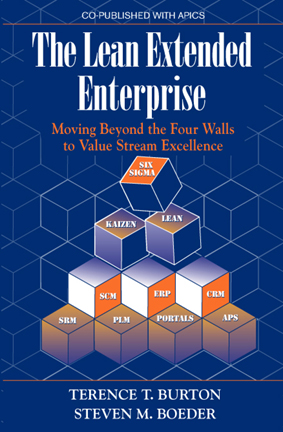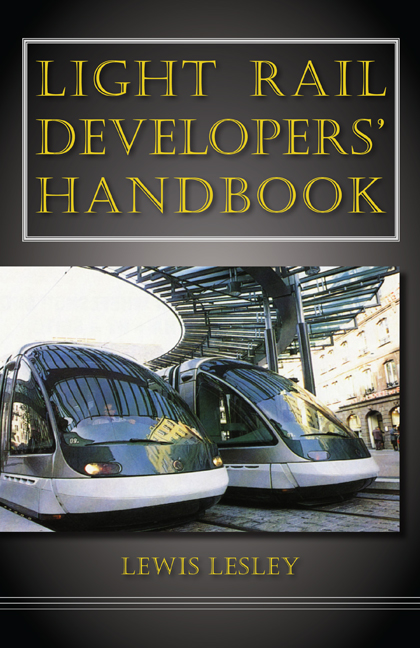Light Rail Developers’ Handbook
$89.95
By Lewis Lesley
Hardcover, 280 pages
ISBN: 978-1-60427-048-8
August 2011
Description
This unique book is for anyone interested in how to justify and build light rail systems in the age of limited resources and green technologies. The historical introduction addresses how many of the problems faced by light rail promoters and planners are not new and how existing solutions can be used to save time and money. The planning chapter explains the process of route identification on the basis of travel patterns and maximizing modal switch. The engineering chapter shows the costs of infrastructure, equipping and commissioning a new light rail system. The economic evaluation chapter shows promoters how each line can be assessed for viability, comparing the capital cost of construction with expected revenue, including sensitivity to different fares, market conditions, and operating costs. In conclusion, the book reviews how to keep a light rail system attractive to riders and investors after opening.
Key Features
- Presents solutions to problems faced by light rail developers and planners saving both time and cost
- Discusses the process of route identification on the basis of travel patterns and maximizing modal switches
- Details the cost structure of equipping and commissioning a new light rail system
- Explains how each rail line can be assessed for viability, comparing capital costs of construction with expected revenue (including sensitivity to different fares and market conditions) and operating costs
About the author(s)
Professor Lewis Lesley is a chartered professional engineer and registered professional engineer who does substantial consulting work for major bus operators, local authorities and rail operators throughout the U.K. and the world. He graduated from Kings College London with a BSc in Mathematics and Physics and received his Ph.D. in Transportation Engineering from Strathclyde University. Dr. Lesley has published more than 200 technical papers in refereed international journals and is the author or editor of 25 books. He has held posts as Public Transport Officer, Durham County Council; Reader in Transport, Liverpool Polytechnic; Professor of Transport Science, Liverpool JM University; and Technical Director, TRAM Power Ltd. In addition, he has been a Visiting Professor at Budapest Technical University, Delft Technical University, National University of Ireland in Maynooth, Széchenyi István University, Rice University, and Leeuwarden Hogeschool.
Table of Contents
Foreword
1.0 Introduction
1.1 The literature on light rail
1.2 The development of light rail
1.3 Environmental Impacts
1.4 Planning light rail
1.5 Engineering light rail
1.6 Affordable light rail
1.7 US TRB Light Rail Study
1.8 UK National Audit Office and Audit Commission Reports
2.0 Characteristics of Light Rail
2.1 Market perception
2.2 Tramways incremental development
2.3 Abandonment and reinvention
2.4 Alignment and locations
2.5 Operation
2.6 Equipment and standards
2.7 Under street utilities
3.0 Planning Light Rail
3.1 Setting goals or objectives
3.2 Demand
3.3 Performance
3.4 Stations and stops
3.5 Land use integration
3.6 Co-ordination with property development
3.7 Meeting civic and environmental objectives
3.8 Co-ordination with property development
3.9 Meeting civic and environmental objectives
3.10 Freight on light rail
4.0 Engineering Light Rail
4.1 Design and other standards
4.2 Design constraints
4.3 Tracks
4.4 Stops and stations
4.5 Depot
4.6 Overhead line and electrification
4.7 Sub stations and distribution
4.8 Construction and installation
4.9 Commissioning
4.10 Maintenance and repairs
4.11 Refurbishment and enhancement
4.12 System extension and development
4.13 Engineering for freight on light rail
5.0 Affordable Light Rail
5.1 Capital costs
5.2 Operating costs
5.3 Patronage. Fares and revenue
5.4 Financial viability
5.5 Project funding
5.6 Economic appraisal and cost benefit analysis
5.7 Implementation and phasing
5.8 Commercial operation
6.0 Marketing
6.1 Marketing
6.2 Advertising and launch
6.3 Building patronage
6.4 Product life cycle
6.5 Re launch
6.6 Staffing
6.7 Community involvement
6.8 Route structure and service frequency
7.0 Case Studies
7.1 San Diego, USA
7.2 Calgary, Canada
7.3 Karlsruhe, Germany
7.4 Nantes, France
7.5 Sheffield, England
7.6 Sydney, Australia
7.7 Galway City (GLUAS), Ireland
8.0 Conclusions
8.1 Meeting community needs
8.2 Satisfying market demands
8.3 Achieving commercial viability
8.4 Learning from experience
8.5 Get it right first time
8.6 Diversification
8.7 Building a network
References
Appendices
Index
Reviews
“This is an excellent handbook that clearly sets out the main facets of tramway design, development and implementation. I found it an inspiring read and I do hope others will take heed of the volume of good advice.”
—David Keay, Her Majesty’s Principal Inspector of Railways
“I absolutely loved reading this book and it helped me realize that the conditions for our proposed line are nearly optimal in terms of operational profitability. What we have may be the first profitable transit line in America.”
—John Krause, CEO, Chicago Streetcar Co.
Related products
-

Leading High-Performance Projects
Retail Price: $44.95$39.95 Add to cart -

Quantitative Methods in Project Management
Retail Price: $64.95$59.95 Add to cart -

Earth Anchors
Retail Price: $79.95$69.95 Add to cart -

The Lean Extended Enterprise
Retail Price: $59.95$49.95 Add to cart -

Winning E-Learning Proposals
Retail Price: $64.95$54.95 Add to cart

